Numerous attempts to win the Serie A have been nothing but close to beating the dead horse for all the Italian clubs. Juventus have dominated the past decade by winning nine titles in that tenure. Inter have shown their ambition by roping Antonio Conte last year and acquiring notable signings under him. They were neck to neck with Juventus last season and came second with only one point behind the champions.
The Italian league is far from being just a two-horse race. Lazio under Simone Inzaghi has been a daunting side in the last four years. They finished fourth on the table last season, tying with Atalanta at 78 points. On 4th October 2020, Lazio hosted Inter at Stadio Olimpico in one the most crucial matches for the title race.
In this tactical analysis, we will decode the gameplay and tactics of both sides. The analysis will examine the events of the match to correlate with the result.
Line-up

Antonio Conte made four changes after his 5-2 win against Benevento. He started with the same 3-4-1-2 formation. Lautaro Martínez came in for former Manchester United player Alexis Sánchez and Nicolò Barella in place of Stefano Sensi. Aleksandar Kolarov paved way for Alessandro Bastoni and Ivan Perišić replaced Ashley Young.
Simone Inzaghi made just one change after a 4-1 loss against Atalanta. Joaquin Correa replaced Felipe Caicedo upfront to pair with Ciro Immobile. Lazio retained it 3-5-2 formation for the game. Lazio suffered two defensive injuries in the match, Radu and Bastos, both players playing as left centre-back.
Lazio’s resistance against Inter’s build-up
‘I Nerazzurri’ were composed on the ball and faced limited pressure in their half. Lazio utilised a mid-block press focusing on conserving the central channel. The back five remained intact because Inter’s wing-backs Hakimi and Perišić joined the last line of attack. Hence primarily the defensive organisation of Lazio was 5-3-2. But the five displayed varying combinations to deal with Inter’s progression as per the situation (3-2, 2-1-2, 2-2-1, 2-3).
As the central channel was closely marked by ‘Le Aquile’, Inter started looking for solutions out wide. Conte’s side wanted to be in control of the ball and therefore played composed football from the back.

In order to get the ball to front four, the central corridor was not an easy option. Therefore, Barella (CAM) started drifting wide on the flanks making a midfield three. Lazio’s pivot Leiva didn’t dare to sacrifice his position to track Barella who was therefore available as a free man.
Inter’s double pivots Gagliardini/Vidal also switched positions with Bastoni/Škriniar depending on which side of the pitch the ball is. This added more width with zero resistance from Lazio. The eventual shape would look as 3-3-4 in the build-up for Inter Milan.
This reduced the central density and created numerical overloads on the flanks during the build-up with three on each side. Škriniar played nine progressive passes and Bastoni played 14 progressive passes with 100% accuracy. Barella played a huge role in ball progression as he constantly floated in the midfield belt with complete freedom. He completed 16 progressive passes successfully.
Retention site
Lazio was least bothered with Inter’s first line of attack’s activities. As their objective was forcing long passes or pushing the play wide. The front five focused on keeping the central space tight as they had the fluidity to move as a group from flank to flank. Bastoni and Škriniar were not just allowed to progress the ball but also carry it.

Lazio had set triggers to retain the ball with pressing. They set the pressing traps in half-spaces and wide areas in their own half. Players would huddle around the ball carrier in their half concealing all the options to win the ball back. Their ball retention was brilliant in the defensive third and made it very difficult to breach the last line of defence.
-
Alterations in the second half

After going 1-0 down in the first half, Lazio showed more enthusiasm in gaining possession. They mixed their pressing style adapting to Inter’s build-up strategy. Immobile pressed Inter’s centre-back De Vrij. Leiva strictly marked Barella in the second half and stayed relatively deeper. Correa, Alberto and Milinković-Savić oscillated to press zonally. When the ball progressed from Inter’s right, Alberto would press Škriniar. Correa and Milinković-Savić stuck to the double pivots Vidal and Gagliardini respectively. This would leave the far side centre-back unmarked in the process.
If the ball shifted across, Alberto would jump to Vidal from Škriniar. Correa kept alternating between the pivots and hence jumped to Gagliardini. Milinković-Savić had the job to then press Bastoni aggressively.

The constant horizontal shift demanded a lot from Lazio’s front five. The distance between the Inter players was maximum due to the width. They also had +1 numerical advantage in the build-up and the pressing angles were not the best to cover the area behind them (Leiva marked Barella). Due to all these reasons, Inter still managed to progress the ball further but only until the back-line intervened.
Inter’s offensive play
‘La Beneamata’ tried to seize the opportunity of the area offered wide from the build-up. With two strikers up top, the wing-backs were instrumental in creating chances. Both Hakimi and Perišić threatened Lazio with nine crosses each. Inter attacked the box to have four targets while crossing. Martínez and Lukaku were supported by Barella who stood deep in the box. The far-side wing-back would also join in to attack the back-post.
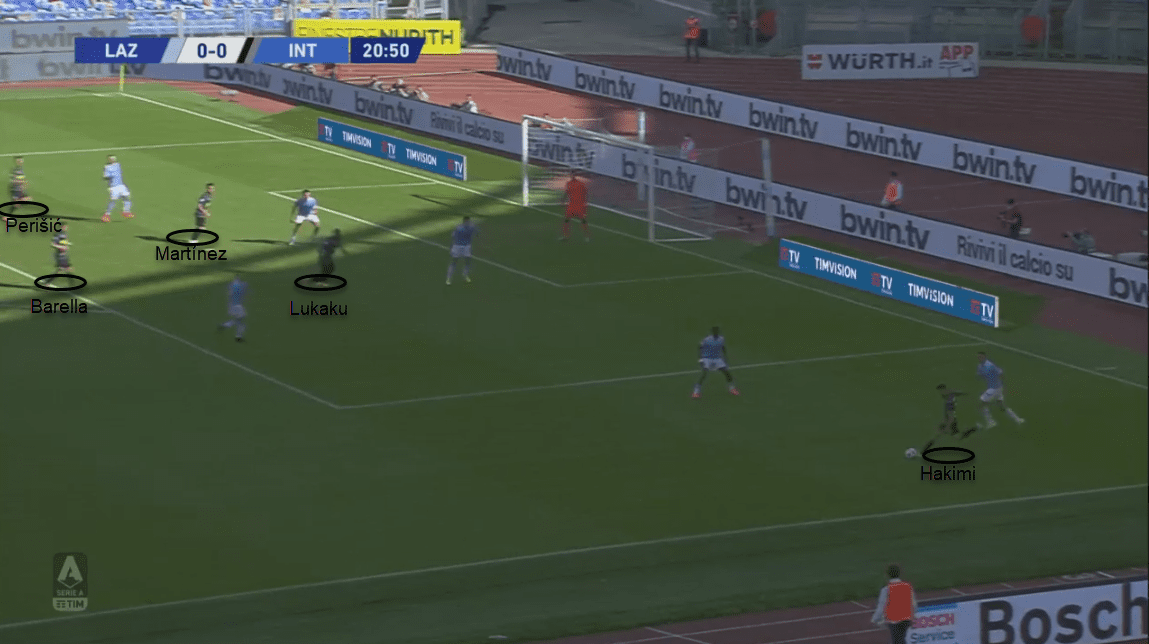
The pacey wing-backs often made runs behind the back-line to collect long passes. Hakimi was unpredictable with his crossing as he possesses the ability to cross with either of his feet. He forced Marušić to commit on one side as to turn the other way round.
Perišić was more direct and penetrating in his approach. Lazzari was therefore too cautious around him and refrained from committing. Perišić, therefore, managed to get inside the box easily. A deflected tackle on him landed the ball straight onto Martínez’s feet which gave them the lead. Hakimi completed four out of five dribbles successfully and Perišić completed six out of seven dribbles successfully.
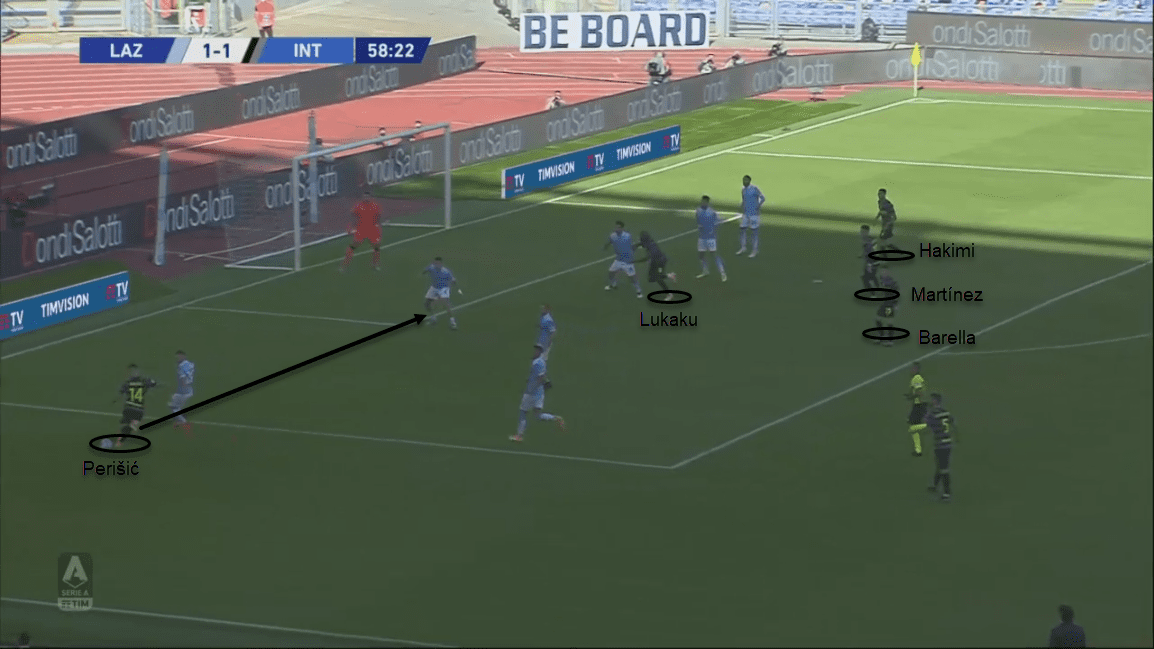
The precision of crosses was a big let-down as the team failed to coordinate the final pass. Lukaku frequently made near-post runs and dragged the backline with him. The above picture shows, Perišić delivers a square ball when three players were waiting for a cut-back. The final movements during crosses were uncoordinated and didn’t have an adequate impact from the box.
Central play
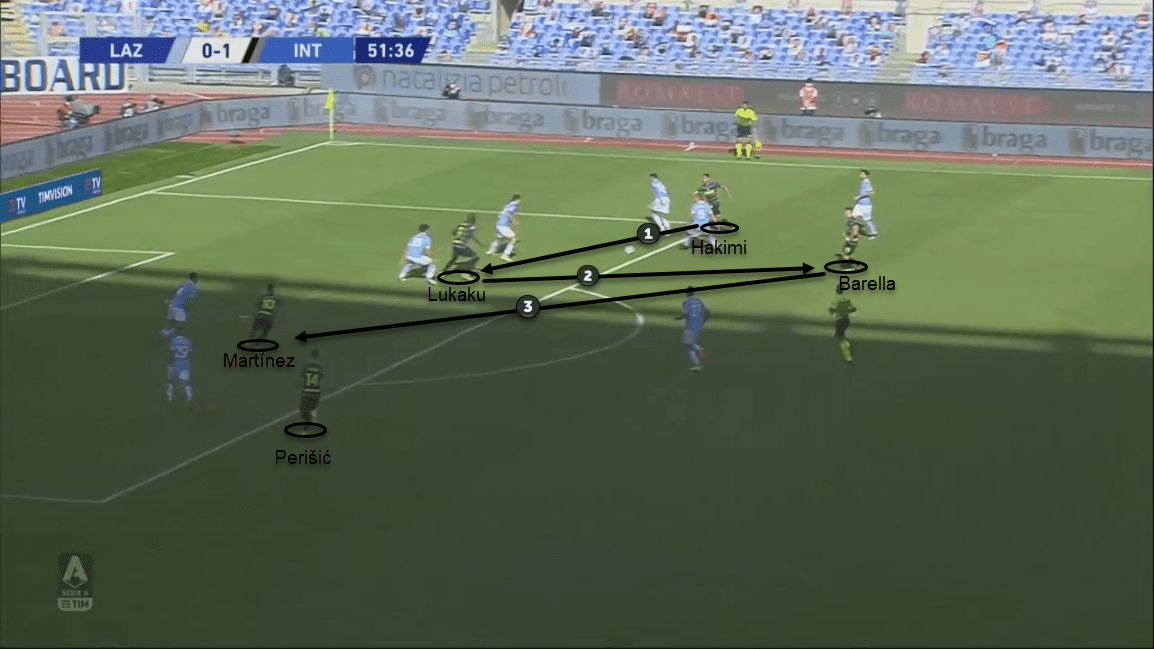
Inter combined in the centre with the help of free playing Barella. He used his freedom to find pockets of spaces and play quick passes in combination. He amalgamated different units in the team to produce a seamless system. The strikers combined with the help of midfielders and wing-backs.
Having said that, Lazio’s defenders deserve huge credit for their contributions. Patric and Acerbi were two defenders who played the full game. They read the game well from the back and made six interceptions each. The wing-backs Marušić and Lazzari too made six and four interceptions respectively. Bastos came in for 30 minutes in place of injured Radu. He engaged in 13 defensive duels and won 12 of them.
Transitions
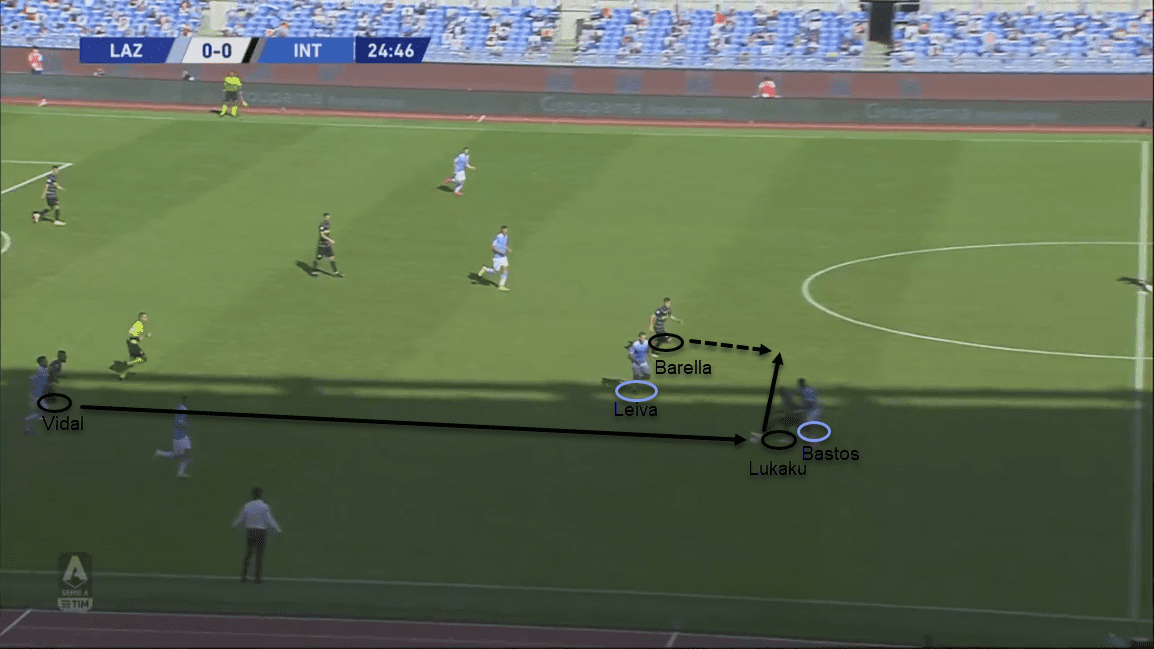
In transitions, Lukaku was the prime outlet of advancement. He played with incredible strength to withstand the pressure from the back. The Belgian forward played with great awareness knowing when to turn and when to pass. He came up against three different LCBs in the game and managed to outmuscle every one of them. When out of options, he had the pace to turn and drift away from his marker.
Inter’s press to hurdle Lazio’s progression
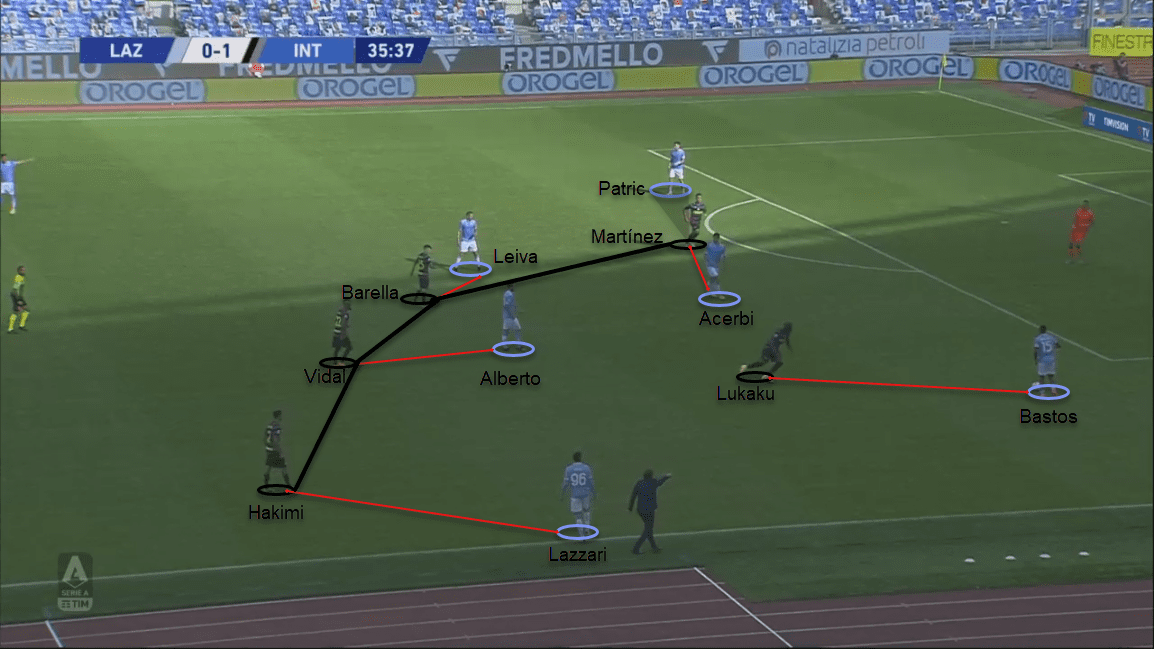
Inter Milan pressed high using man-to-man marking against Lazio. Martínez marked Patric to eliminate the option on the left. As soon as Strakosha would pass it on the right (w.r.t Inter), Martínez moved from Patric (cover-shadow) to Acerbi. The small tactical play from Martínez helped in forcing the play in one vertical half, always to the right. Rest of the players man-marked the remaining passing options. Out of possession, Lukaku shifted to his right and always marked Lazio’s Left Centre-Back. Barella was strictly instructed to stay with Leiva knowing how crucial he is in build-up and progression. The pressing scheme helped in regaining possession in opposition’s half and created two goal-scoring opportunities.
The other vertical half
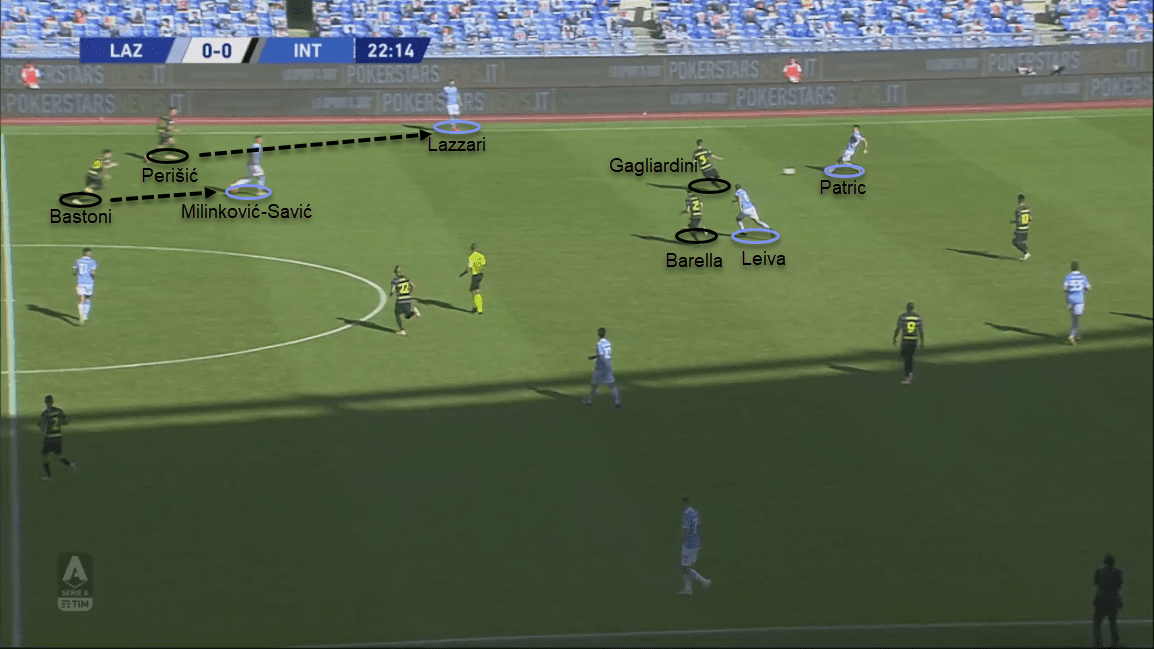
If Lazio managed to build from their right which Inter tried to restrain, then ‘Il Biscione’ followed a different pressing routine. Gagliardini was tasked to leave Milinković-Savić and press Patric when he received the ball. Bastoni/De Vrij would then step out of the back-line to mark Milinković-Savić and adjust the team shape accordingly.
The Serbian midfielder positioned himself higher on the pitch when his team is in possession. Therefore it was Bastoni’s responsibility to not give time on the ball or let him turn as it could be menacing. Gagliardini had to get through the hardships of covering the diagonal distance from centre-midfielder to wide centre-back.
The tremendous distance to cover for pressing often offered Patric enough time to pick his pass. Inter could have suffered worse by giving Patric enough time on the ball. His passing was exceptional. Patric played 10 progressive passes and 5 long passes with a perfect record. He played 56 passes in the game with 100% accuracy.
Blemish in the process
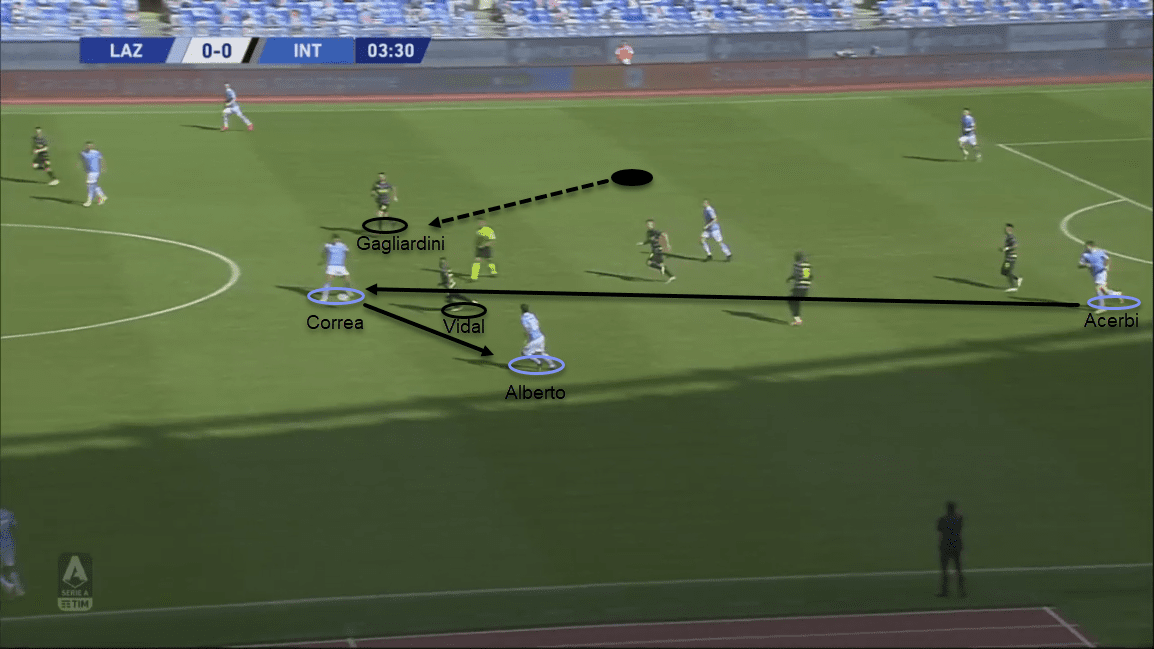
Gagliardini also took time to recover his position after pressing Patric, this left Vidal isolated in the centre. Correa and Immobile dropped in the centre to aid the third man run which is an extensively used tactic by Lazio to progress the ball. Acerbi too had his fair share in contributing from build-up. He is a player who likes play penetrating passes from the back and to carry the ball from the deep whenever the opportunity arises. After Bastos’ injury, Acerbi played as an LCB and surged higher up the pitch to support his LWB. His cross assisted Lazio getting the equaliser.
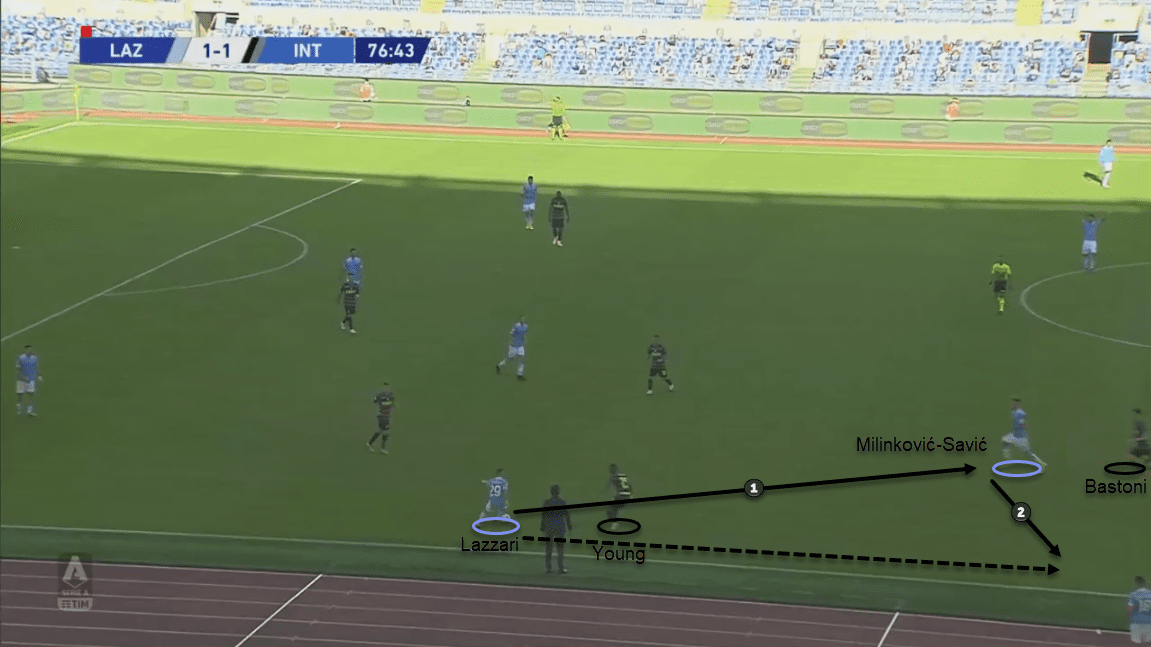
A strict man-marking is always susceptible to sharp movements, leaving space behind and quick combinations. Lazzari and Milinković-Savić engaged in quick one-twos on two occasions when they were pressed by Inter’s LWB and LCB respectively. Lazzari has the speed to outrun both Young and Perišić easily. Inter dealt with the situation by committing a tactical foul on one occasion and dealing with a cross from Lazzari on the other.
Lazio’s offensive play
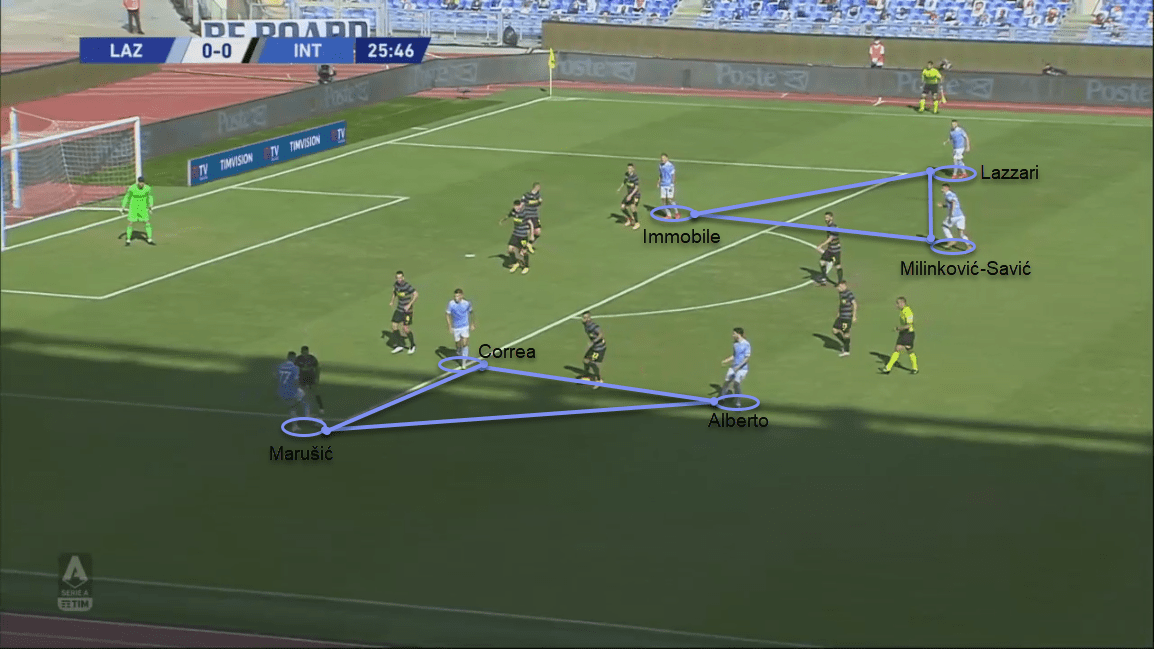
‘I Biancocelesti’ set-up with six players in the final-third when in possession. They look to create two triangles with a forward, a midfielder and a wing-back in each. The set-up mostly occupied the half-space and flanks, leaving the central corridor unoccupied. Leiva stayed behind in the central channel, primarily used to switch the play and confront counter-attacks. The three centre-backs stayed as rest defence but Acerbi joined the attack when needed.
The triangles were very effective in creating chances to score. Inter defended in 5-2-1-2, which meant that the lacked players to cover the wide areas in midfield. Lazio took advantage of that in delivering early crosses from deep.
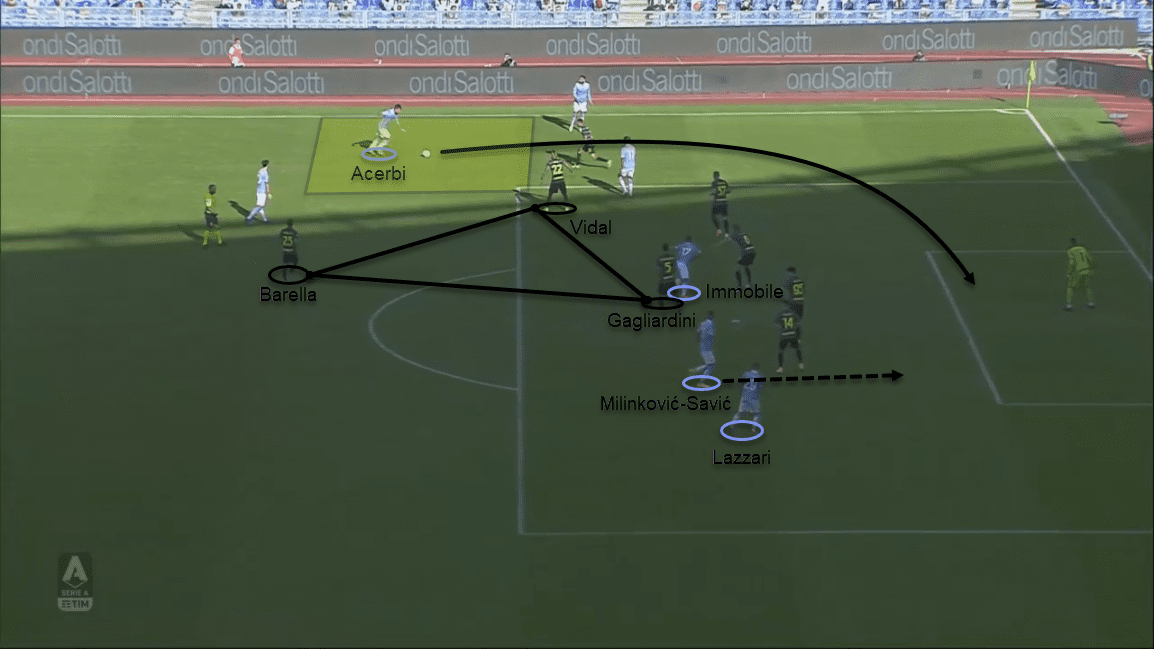
The far side players from triangle darted the penalty-area creating a flat three. This was done to maximise the space and give multiple crossing targets. The quality of cross was ensured as Inter lacked midfield width to block or delay crosses from deep. Milinković-Savić was not just the target at the far post but was actively involved in delivering crosses (3) at the opposite end.
The trios also combined to interchange positions and unorganised Inter’s backline. Luis Alberto and Milinković-Savić provided a threat from the outside of the box with their long shots. Alberto took four shots with two on target and Milinković-Savić took two with both being on target. Correa and Immobile did not just make runs inside the box but also supported the player on the ball.
Transitions
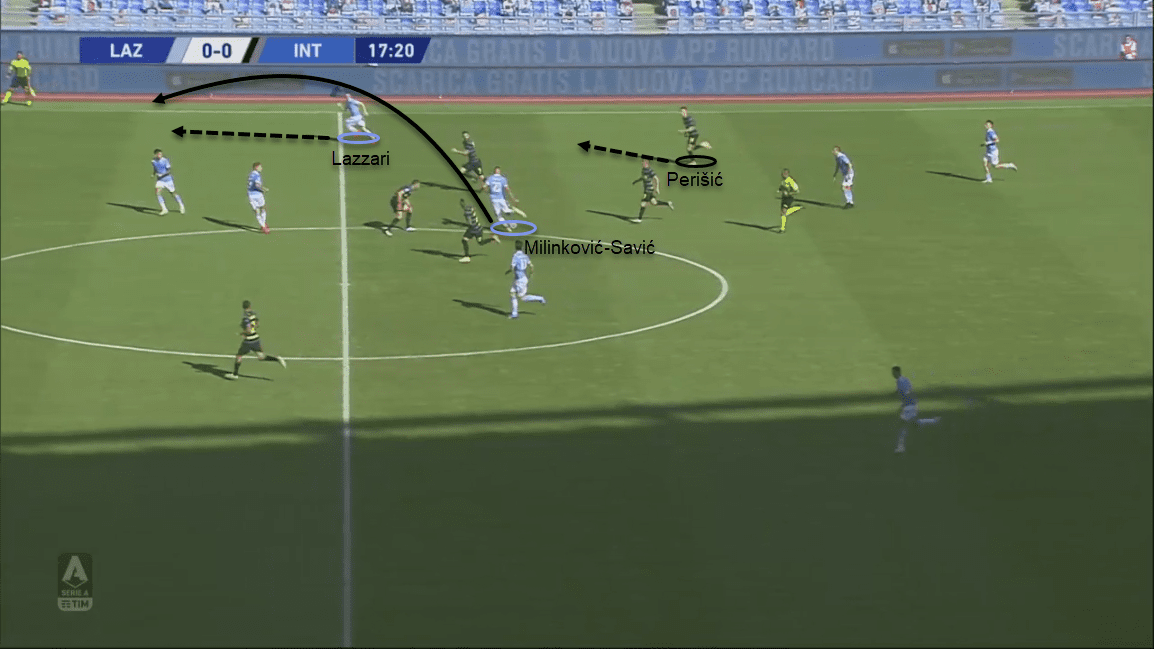
Inter had committed their wing-backs till the final-third when they had possession. Lazio’s strategy was simply to make the most of it. The two strikers engaged Inter’s back three and Lazzari had the pace, space and time to march forward. Le Aquile tried to find him on every break as he made robust runs ahead of Perišić. Inzaghi’s team looked dangerous on turnovers with Lazzari’s direct approach and crossing. Correa had two opportunities from the crosses but the timing of jump and the elevation didn’t correspond well. Lazio attempted seven counter-attacks in the match.
Summary
The last twenty minutes were thrilling as both sides got a red card on separate occasions. Lazio defended well with 10 men in a 5-4 diamond formation to secure a point. Inter dominated the game in terms of possession but looked vulnerable off the ball. Both the Italian sides displayed unique pressing styles curated based on each other’s style of play. 1-1 was a fair end to this amusing match.





Comments